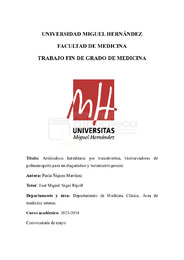Please use this identifier to cite or link to this item:
https://hdl.handle.net/11000/33865Amiloidosis hereditaria por transtirretina, biomarcadores de polineuropatía para un diagnóstico y tratamiento precoz.
| Title: Amiloidosis hereditaria por transtirretina, biomarcadores de polineuropatía para un diagnóstico y tratamiento precoz. |
| Authors: Ñíguez Martínez, Paula |
| Tutor: Seguí Ripoll, José Manuel |
| Editor: Universidad Miguel Hernández |
| Department: Departamentos de la UMH::Medicina Clínica |
| Issue Date: 2024-05-14 |
| URI: https://hdl.handle.net/11000/33865 |
| Abstract: Introducción: la amiloidosis hereditaria por transtirretina (ATTRv) es una enfermedad rara y multisistémica, causada por la acumulación de fibrillas de transtirretina (TTR) en las células. El depósito de transtirretina en el sistema nervioso periférico provoca daño en los nervios y favorece su degeneración. La identificación temprana del inicio o progresión de la polineuropatía en la amiloidosis ATTRv todavía se retrasa debido a la falta de biomarcadores validados. Hipótesis: el estudio de nuevos biomarcadores en pacientes con amiloidosis ATTRv con polineuropatía (PN) puede ser útil para un diagnóstico y tratamiento precoz, mejorando así el curso de la enfermedad. Objetivos: describir los principales biomarcadores descritos en la ATTRv con PN en los últimos 5 años, así como evaluar su valor diagnóstico, su función como marcadores de progresión de la enfermedad y utilidad como indicadores predictivos y pronósticos de la respuesta al tratamiento. Material y métodos: se ha realizado una revisión bibliográfica para recopilar la evidencia del uso de biomarcadores de polineuropatía en la amiloidosis ATTRv en los últimos 5 años, utilizando palabras clave como “Amyloidosis, Hereditary, Transthyretin-Related”, “biomarkers”, “early diagnosis” en Pubmed, Scopus y WebOfSciece, seleccionando 16 artículos. Resultados: la evidencia científica hallada muestra que determinados biomarcadores, entre los que destaca las cadenas ligeras de neurofilamentos (NfL), neurografía por resonancia magnética (MRN), imágenes de tensor de difusión (DTI), determinadas citocinas, depósitos de amiloide en la piel y niveles circulantes de TTR no nativo (NNTTR), pueden ser útiles para el diagnóstico, pronóstico y monitorización de respuesta al tratamiento en pacientes con amiloidosis ATTRv con polineuropatía. Conclusiones: Los resultados suponen un avance para el estudio de la enfermedad, sin embargo, se requiere de estudios o ensayos clínicos más amplios y longitudinales para comprender mejor el papel de estos biomarcadores en la enfermedad y su utilidad en la práctica clínica. Introduction: Hereditary transthyretin amyloidosis (ATTRv) is a rare, multisystem disease caused by the accumulation of transthyretin (TTR) fibrils in cells. The deposition of transthyretin in the peripheral nervous system causes damage to the nerves and promotes their degeneration. Early identification of the onset or progression of polyneuropathy in ATTRv amyloidosis is still delayed due to the lack of validated biomarkers. Hypotesis: The study of new biomarkers in patients with ATTRv amyloidosis with polyneuropathy (PN) may be useful for early diagnosis and treatment, improving the course of the disease. Aim: describe the main biomarkers described in ATTRv with PN in the last 5 years, as well as evaluate their value for diagnosis and progression and their usefulness as predictive and prognostic indicators of the response to treatment. Methods: A bibliographic review has been carried out to compile evidence of the use of biomarkers of polyneuropathy in ATTRv amyloidosis in the last 5 years, using keywords such as “Amyloidosis, Hereditary, Transthyretin-Related”, “biomarkers”, “early diagnosis” in Pubmed, Scopus and WebOfSciece, selecting 16 articles Results: The scientific evidence found shows that certain biomarkers, including nuerofilament light chains (NfL), magnetic resonance neurography (MRN), diffusion tensor imaging (DTI), certain cytokines, amyloid deposits in the skin and levels of circulating non-native TTR (NNTTR), may be useful for diagnosis, prognosis and monitoring of response to treatment in patients with ATTRv amyloidosis with polyneuropathy Conclusions: The results represent an advance for the study of the disease, However, larger and more longitudinal studies or clinical trials are required to better understand the role of these biomarkers in the disease and their usefulness in clinical practice. |
| Keywords/Subjects: Amiloidosis ATTRv biomarcadores transtirretina polineuropatía diagnóstico temprano |
| Knowledge area: CDU: Ciencias aplicadas: Medicina |
| Type of document: info:eu-repo/semantics/bachelorThesis |
| Access rights: info:eu-repo/semantics/openAccess Attribution-NonCommercial-NoDerivatives 4.0 Internacional |
| Appears in Collections: TFG- Medicina |
.png)

